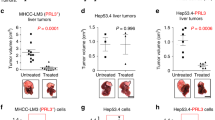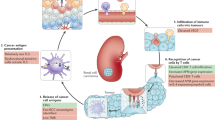Abstract
The resistance of tumours to immune-mediated lysis has been linked to the biology of matrix metalloproteinases (MMPs), and specifically to the cell surface expression of MMPs by the tumour cell. The endogenous tissue inhibitors of metalloproteinases (TIMPs) exhibit diverse physiological/biological functions including the moderation of tumour growth, metastasis and apoptosis. These biologic activities are mediated in part by the stoichiometry of TIMP/MMP/cell surface protein interactions. A glycosylphosphatidylinositol (GPI) anchor was fused to TIMP-1 to focus defined concentrations of this inhibitory protein on the surface of three renal cell carcinoma (RCC) cell lines (RCC-26, RCC-53 and A498) independently of cell surface protein–protein interactions. Exogenously added TIMP-1-GPI efficiently inserted into the RCC cell membrane and dramatically altered the association of MMPs with the cell surface. TIMP-1-GPI treatment inhibited RCC proliferation and rendered the normally FAS-resistant RCC cells sensitive to FAS-induced apoptosis but did not alter perforin-mediated lysis by cytotoxic effector cells. The increased sensitivity to FAS-mediated apoptosis correlated with an alteration in the balance of pro- and antiapoptotic BCL-2-family proteins. By interfering with the proliferative capacity and inducing sensitivity to immune effector mechanisms GPI-anchored TIMP-1 may represent a more effective version of the TIMP-1 protein for therapeutic strategies.
This is a preview of subscription content, access via your institution
Access options
Subscribe to this journal
Receive 50 print issues and online access
$259.00 per year
only $5.18 per issue
Buy this article
- Purchase on Springer Link
- Instant access to full article PDF
Prices may be subject to local taxes which are calculated during checkout










Similar content being viewed by others
References
Ahonen M, Poukkula M, Baker AH, Kashiwagi M, Nagase H, Eriksson JE et al. (2003). Oncogene 22: 2121–2134.
Baker AH, George SJ, Zaltsman AB, Murphy G, Newby AC . (1999). Br J Cancer 79: 1347–1355.
Baker AH, Zaltsman AB, George SJ, Newby AC . (1998). J Clin Invest 101: 1478–1487.
Barnstable CJ, Jones EA, Crumpton MJ . (1978). Br Med Bull 34: 241–246.
Bigda J, Beletsky I, Brakebusch C, Varfolomeev Y, Engelmann H, Holtmann H et al. (1994). J Exp Med 180: 445–460.
Bloomston M, Shafii A, Zervos EE, Rosemurgy AS . (2002). J Surg Res 102: 39–44.
Bode W, Maskos K . (2003). Biol Chem 384: 863–872.
Bond M, Murphy G, Bennett MR, Newby AC, Baker AH . (2002). J Biol Chem 277: 13787–13795.
Brand K . (2002). Curr Gene Ther 2: 255–271.
Brew K, Dinakarpandian D, Nagase H . (2000). Biochim Biophys Acta 1477: 267–283.
Brown O, Cowen RL, Preston CM, Castro MG, Lowenstein PR . (2000). Gene Therapy 7: 1947–1953.
Djafarzadeh R, Mojaat A, Vicente AB, von Luttichau I, Nelson PJ . (2004). Biol Chem 385: 655–663.
Dunn GP, Old LJ, Schreiber RD . (2004). Annu Rev Immunol 22: 329–360.
Egeblad M, Werb Z . (2002). Nat Rev Cancer 2: 161–174.
Frost P, Caliliw R, Belldegrun A, Bonavida B . (2003). Int J Oncol 22: 431–437.
Giard DJ, Aaronson SA, Todaro GJ, Arnstein P, Kersey JH, Dosik H et al. (1973). J Natl Cancer Inst 51: 1417–1423.
Gong JH, Maki G, Klingemann HG . (1994). Leukemia 8: 652–658.
Hemmerlein B, Johanns U, Halbfass J, Bottcher T, Heuser M, Radzun HJ et al. (2004). Int J Oncol 24: 1069–1076.
Igney FH, Krammer PH . (2002). Nat Rev Cancer 2: 277–288.
Itoh Y, Nagase H . (2002). Essays Biochem 38: 21–36.
Johnson JP, Stade BG, Hupke U, Holzmann B, Riethmuller G . (1988). Immunobiology 178: 275–284.
Kagi D, Vignaux F, Ledermann B, Burki K, Depraetere V, Nagata S et al. (1994). Science 265: 528–530.
Kirby AC, Hill V, Olsen I, Porter SR . (1995). Biochem Biophys Res Commun 214: 200–205.
Klier CM, Nelson EL, Cohen CD, Horuk R, Schlondorff D, Nelson PJ . (2001). Biol Chem 382: 1405–1410.
Lang R, Braun M, Sounni NE, Noel A, Frankenne F, Foidart JM et al. (2004). J Mol Biol 336: 213–225.
Mack M, Riethmuller G, Kufer P . (1995). Proc Natl Acad Sci USA 92: 7021–7025.
Majid MA, Smith VA, Easty DL, Baker AH, Newby AC . (2002). Br J Ophthalmol 86: 97–101.
Medof ME, Nagarajan S, Tykocinski ML . (1996). FASEB J 10: 574–586.
Milani V, Frankenberger B, Heinz O, Brandl A, Ruhland S, Issels RD et al. (2005). Int Immunol 17: 257–268.
Nagase H, Woessner Jr JF . (1999). J Biol Chem 274: 21491–21494.
Nagata S . (1999). Annu Rev Genet 33: 29–55.
Parham P, Brodsky FM . (1981). Hum Immunol 3: 277–299.
Rigg AS, Lemoine NR . (2001). Cancer Gene Ther 8: 869–878.
Robertson MJ, Cochran KJ, Cameron C, Le JM, Tantravahi R, Ritz J . (1996). Exp Hematol 24: 406–415.
Sayers TJ, Brooks AD, Lee JK, Fenton RG, Komschlies KL, Wigginton JM et al. (1998). J Immunol 161: 3957–3965.
Schendel DJ, Frankenberger B, Jantzer P, Cayeux S, Noessner E, Willimsky G et al. (2000). Gene Therapy 7: 2007–2014.
Schendel DJ, Gansbacher B, Oberneder R, Kriegmair M, Hofstetter A, Riethmuller G et al. (1993). J Immunol 151: 4209–4220.
Schendel DJ, Oberneder R, Falk CS, Jantzer P, Kressenstein S, Maget B et al. (1997). J Mol Med 75: 400–413.
Seki N, Brooks AD, Carter CR, Back TC, Parsoneault EM, Smyth MJ et al. (2002). J Immunol 168: 3484–3492.
Smith MR, Kung H, Durum SK, Colburn NH, Sun Y . (1997). Cytokine 9: 770–780.
Span PN, Lindberg RL, Manders P, Tjan-Heijnen VC, Heuvel JJ, Beex LV et al. (2004). J Pathol 202: 395–402.
Trapani JA, Davis J, Sutton VR, Smyth MJ . (2000). Curr Opin Immunol 12: 323–329.
Vogelzang NJ, Stadler WM . (1998). Lancet 352: 1691–1696.
Zacchigna S, Zentilin L, Morini M, Dell'Eva R, Noonan DM, Albini A et al. (2004). Cancer Gene Ther 11: 73–80.
Acknowledgements
This work was supported by SFB 571 (C2), GRK438, a MUCOS-Stifung and DFG grant (NE 648/2-1) to PJN. SFB455 supported EN and DJS (Projects C5 and C1, respectively) and Madleine Schickedanz KinderKrebsstiftung and MUCOS-Stifung support was given to IvL.
Author information
Authors and Affiliations
Corresponding author
Rights and permissions
About this article
Cite this article
Djafarzadeh, R., Noessner, E., Engelmann, H. et al. GPI-anchored TIMP-1 treatment renders renal cell carcinoma sensitive to FAS-meditated killing. Oncogene 25, 1496–1508 (2006). https://doi.org/10.1038/sj.onc.1209188
Received:
Revised:
Accepted:
Published:
Issue Date:
DOI: https://doi.org/10.1038/sj.onc.1209188
Keywords
This article is cited by
-
Cytokine functions of TIMP-1
Cellular and Molecular Life Sciences (2014)
-
Recombinant TIMP-1-GPI inhibits growth of fibrosarcoma and enhances tumor sensitivity to doxorubicin
Targeted Oncology (2014)
-
Treatment of Dermal Fibroblasts with GPI-Anchored Human TIMP-1 Protein Moderates Processes Linked to Scar Formation
Journal of Investigative Dermatology (2013)
-
TIMP-1-GPI in combination with hyperthermic treatment of melanoma increases sensitivity to FAS-mediated apoptosis
Cancer Immunology, Immunotherapy (2009)



